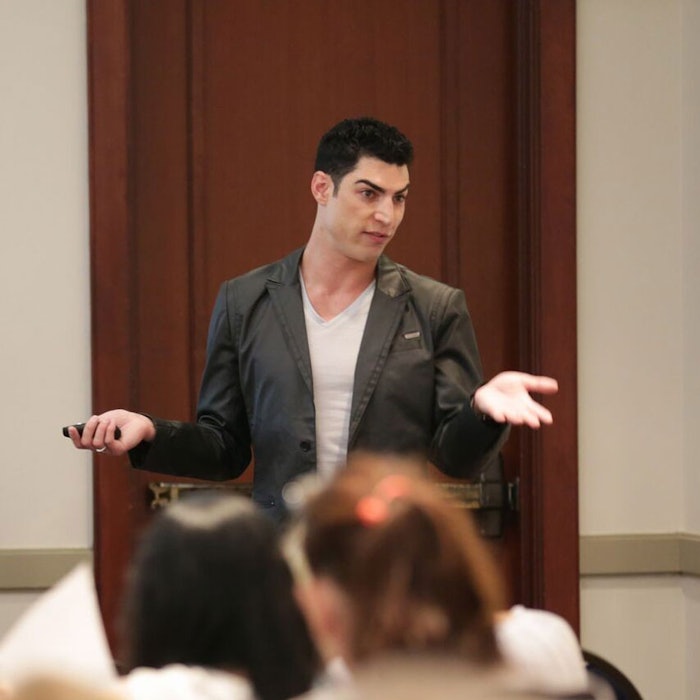
In order to bring spa professionals advanced education in the science realm, Face & Body Southeast invited five speakers to share their knowledge on various topics. Attendees had the opportunity to take away from lessons about peptides, eczema and psoriasis, natural cosmeceuticals, genetically modified organisms (GMOs) and skin analysis for problematic skin.
Improving Skin With Peptides
Christopher Kuever from Circadia by Dr. Pugliese kicked off the science track with his class, The Next Generation of Peptide Technology. According to Kuever, peptides are a type of technology, which benefit skin conditions such as aging, pigmentation, acne and rosacea.
“Peptides are biochemical structures composed of amino acids linked in what is known as a peptide bond,” explained Kuever.
Peptides have four families, which according to Kuever, are both fascinating and significant. The categories include:
- Carrier peptides
- Signal peptides
- Neurotransmitter peptides
- Enzyme modulating peptides
Developing peptides is an art and a science, said Kuever. Canada, Spain and Monaco are three major countries producing them, he said. Although it may take years to develop the perfect peptide—as they are not perfect by nature—once the right formula is created, the results will be exactly what estheticians are looking for.
“It takes at least six weeks to start affecting the skin and the cells the way we’re looking for,” said Kuever.
Skin Treatment and Client Education
With 25 years in the skin care and wellness industries, Goldie Bonnell from Pevonia led the Eczema and Psoriasis in the Treatment Room class. She emphasized on teaching clients about skin care and how to care for their skin.
With nine types of eczema and eight types of psoriasis, spa professionals must get to know their clients and what their daily habits or routines look like. While cosmetics may be the biggest cause with clients, food intake or diet plays a significant role as well.
“Have clients make a list,” she said. “What are you getting in contact with every day?”
Another key thing for spa professionals to do is help clients get inflammation under control and advise them to look into stress relievers.
“Stress seems to be a trigger in every condition we talk about,” she said.
Other forms of treatment include breathing exercises, pressure point massage and aromatherapy, among other actions to control problematic skin.
Natural and Organic Ingredients
In Robert Manzo’s Natural Cosmeceuticals: Myths & Realities, the Skinprint founder, developer and president explained what to expect or not expect when using natural ingredients in skin care products.
Manzo gave his listeners a decoding label with:
- The few letters an ingredient ends in such as, “ones” or “ates”
- An example of each ending such as, “cyclomethicone” or “octisalate: sunscreen”
- The function of each example such as, “silicones: slip & feel” or “sunscreens are UV inhibitors”
Using companies, Origins, Credo and Jurlique, Manzo pulled up an image of a product from each brand with its ingredients label. He interacted with the crowd in utilizing the chart by asking what each ingredient would mean and whether this proved to be natural.
Additionally, Manzo’s takeaway was to utilize squalene oil, which is a positive synthetic for women to use as they age, helping express sebum. Use squalene oil or an ester-like squalene to save aging women's skin, he said.
GMO Safety
As part of the UCLA Extension, Rebecca Gadberry brought spa professionals insight on GMO technologies in her class, GMOs: Should You Be Wary or Welcoming?
Gadberry explained how spa professionals need to talk to their clients about GMOs and genetically modified micro-organisms (GMMs). There are many concerns about this within hair care and skin care, and while one can be cautious of new technologies, there are also benefits that come from all this.
After 13 years and $130 million, science for GMOs look safe, said Gadberry. Rather than banning GMO technologies, they should be regulated, she added. To avoid GMOs, clients should look for the certified organic seal, which is USDA approved.
Analyzing Skin and Problematic Conditions
After moderating the track for the day, Lyn Ross, founder of Institut’ DERMed Clinical Skin Care led the final class of the track, Advanced Skin Analysis for Problematic Skin Conditions, teaching attendees the proper way to evaluate skin.
Similar to Bonnell’s suggestion, Ross recommended for professionals to talk to their clients about their medical history and lifestyle habits to understand what may be impacting skin to look the way it does. According to Ross, she works out and watches her diet with proper intake daily.
To analyze skin further, Ross explained the SOAP format chart:
- Subjective – what they see
- Objective – what you see
- Assessment – establish realistic goals
- Plan – development plan
Further, she analyzes skin conditions based on type, color, acne grades, rosacea, photo damage and photo aging. Ross referred to acne excoriee or picker’s acne and explained how estheticians must instruct their clients to avoid touching any type of skin damage or issue.
“We have to train [clients] to keep their hands off their skin,” she said.
Additionally, she suggested for mainly positive thoughts for clients.
“Appearance plays a big role in lifting self-esteem,” said Ross. “You have to get up every day and work on skin care. You have to get up every day to work on self-esteem. You have to work on skin care to work on self-esteem.”
Until January
If you missed the inaugural Southeast show, make sure to catch the Face & Body Midwest show in January at a new location. The show will include new products, treatments, company news, various advanced education classes and more.










